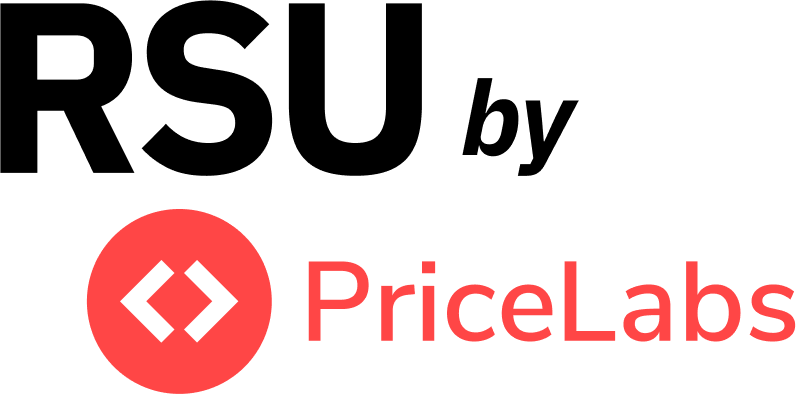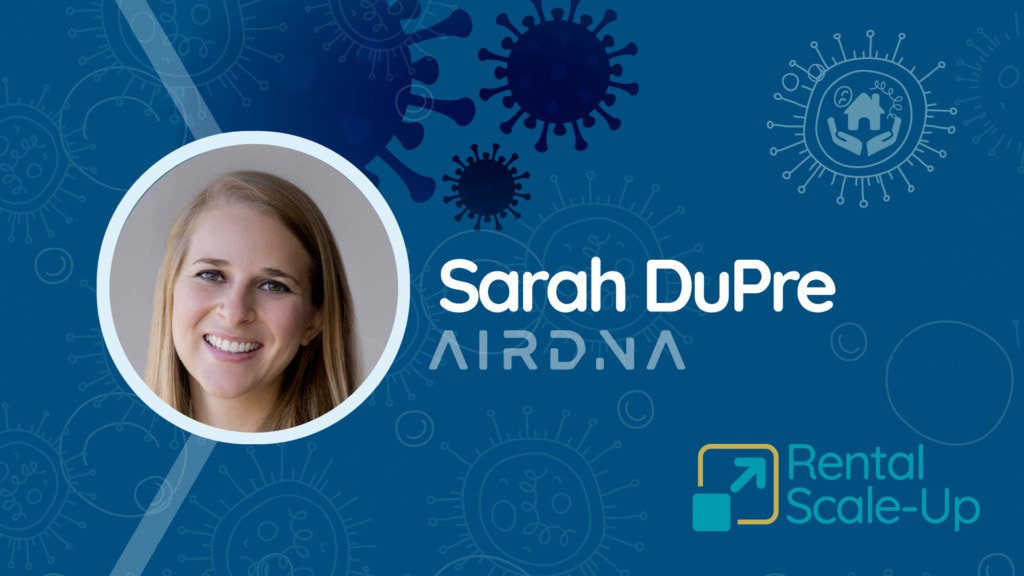This article is part of our Rental Scale-Up vacation rental management conference series. This is an extract from our April 2020 conference: “Get Your Business Through the COVID-19 Crisis By Discovering How Local Property Managers Resist the Global Coronavirus Epidemic.”
Vacation Rental Management Conference: AirDNA’s Sarah DuPre
To help you better take action for your own market, Sarah DuPre, from data company AirDNA, will walk you through the brand new tools released for her company. She will explain why historical data do not work as we are hit by an unprecedented pandemic and why you need to look at the patterns of the new bookings in your area: For which dates are people still booking? How far in advance? How are your 2020 rates compared with those of the properties that are being booked? How is the decrease of supply in your area affecting the metrics that you are looking at? Where you can get this data for your own local market?
Vacation Rental Management Conference: Video From The 2020 Local Property Manager Conference
- Sarah and her team at AirDNA are currently working on gathering data from property managers to assess the state of the short-term rental industry. AirDNA was surprised to see new bookings showing in their data sets, so they spoke with property managers in the Barcelona area who confirmed that they are indeed receiving bookings.
- These new bookings fell into two categories:
- Medical professionals and family members who needed a place to stay in an area near the hospital
- People looking for a quiet place to work, perhaps if they have kids or other distractions at home
- The Hamptons market, for example, is seeing a big increase in bookings (300%) driven by people leaving NYC to self-isolate outside the city.
- Travel may be more localized this year; that is, people will travel within their own country rather than internationally due to lockdowns and travel restrictions.
- Since short-term rental pricing tools (Pricelabs, Airbnb’s Smart Pricing, even AirDNA’s own tool) provide recommendations based on historical data and trends, their recommendations aren’t necessarily accurate right now. Some of these tools have even disabled their services because they recognize that they can’t make accurate predictions when the market is in such an uncertain state.
- Sarah’s team is now developing ways to provide valuable insight based on the data they do have. They’re comparing historical market performance with current performance to see whether markets are recovering or not and what the pace of recovery looks like.
- AirDNA’s new Future Demand Analysis dashboard looks at “pacing,” which is a term that refers to what’s happening right now compared to what was happening at the same time last year.
- The first graph on the dashboard shows the number of available listings compared to the number of booked listings on a given day, showing the occupancy rate of the market.
- The second graph shows the median booked rate for this year and last year. The intention is to track the convergence of the two lines (this year and last year).
- In addition, you can filter to show only reservations made in the last 60, 30, and 7 days.
- AirDNA pulls in data for every Airbnb and Vrbo listing in the world.
- What about bookings made on platforms other than Airbnb and Vrbo? AirDNA uses booking data from medium to large property management companies who use channel managers as well as calendar availability from individual hosts to determine overall property performance. Even if a booking was made through another channel, the availability will be blocked on Airbnb and Vrbo, so AirDNA can see that a booking was made.
- AirDNA now has a free dashboard that shows high-level data by country, so property managers can see overall trends for their country even without an AirDNA subscription.
- A subscription is needed to see city-level data.
- This data allows property managers to understand what’s happening in their market and helps them forecast demand and manage pricing for future dates.
Vacation Rental Management Conference: Full Conversation Between Sarah DuPre And Thibault Masson
Thibault:
Dear Rental Scale-Up members. Thank you for joining us for this new session today. Right now we have Sarah DuPre, Sarah work for AirDNA, which is a data company, a, they know all about what’s going on in the markets all around the world when it comes to short term rental and or short term rentals and vacation rentals. So she’ll be talking to us about a few things among which what situation is like for her. She’s actually in Barcelona as we know, Spain is a country that’s been very much shaped by the coronavirus. So having us always local perspective brings it out to us. And talking about your core perspective, we’ll see that there’s actually bookings happening right now in Barcelona, which will tell us how, through talking with property managers like you and AirDNA datasheet, they’ve been able to know what was going on.
Thibault:
And then we’ll talk about things like pricing. How do you price your properties right now? You may think that you have usually helps from it say dynamic pricing tools or from a tools like Airbnb, spike pricing or verbals, a market maker, a pricing opportunities. And that these things may be, are not as reliable. They used to be because a lot of them are relying on historical data, right? Obviously these data does not do not account for a global pandemic. So we’ll see why the night be and rival. And so we’ll talk about what, which metrics should we look into right now to understand what’s happening now in your own market or, so how can you spot recovery? Right? I can see the first site and that’s when someone will basically also share with us her screen to show us the tools that AirDNA has just developed to show you the pace of the new new bookings and other kind of very interesting information that’s gonna help you get a sense of control of the situation and be ready for the future. So, Sarah, welcome. Thank you for taking the time.
Sarah:
Thanks so much Thibault for having me.
Thibault:
What was I saying? You are, you’re welcome as saying you invested in our right now. So can you, can you share about the situation for yourself?
Sarah:
Yeah, absolutely. So in Barcelona, obviously everybody’s on lockdown, so we can only leave the house, go to the supermarket or pharmacy. Some sort of like sectors in construction and things can, can return to work. But everybody can work from home should. I’m a bit lucky. I’m out in the countryside outside of Barcelona, so I usually have a two hour commute, but now I have a bit more peace and quiet and some of my colleagues, so I’m quite lucky. I think it’s just about like everybody else staying positive, staying home, staying as connected as we can through, you know, online, video conferencing and things like that. So there, there is a light at the end of the tunnel, that’s for sure.
Thibault:
And and you’re talking about saying connected. I think what I’ve been very impressed with is that by two things, right? First property managers are still reaching out to you, right? They’re still telling you what’s happening right now in second that your own team, I guess it’s you based in vessel owner, this for people in London, in the U S you’ve also been able to get together to develop new tools. So can you first maybe tell us about how the local markets, what you know, what’s going on for property managers right now in Barcelona?
Sarah:
Yeah, absolutely. So, so the first thing that we looked at, of course, nobody was prepared for a global pandemic. None of our tools or models and algorithms were built for that. And so that was sort of the first thing that hit us was, Hey, we really need to speak with our data partners, speak with our property management clients and see what’s really happening out there and see how that’s reflected in the data. And so one of the interesting things that we noticed is that we were actually seeing bookings. Our algorithm was picking up bookings. We were seeing it in the, in some of the data anonymized data received through our data partnerships. And we were a bit perturbed. So we called up some of our property management clients and said, Hey guys, are you actually getting bookings or are we missing the Mark?
Sarah:
And happily they actually were receiving bookings. So we talked to several different clients in areas where we were seeing an increase. One of those, of course was in Barcelona. And when we rang up our property managers, they said yes. So we are receiving bookings mainly for two reasons in Barcelona. The first was that on day one they had some of them are taken the initiative to go down to the hospitals and stand outside of the health centers. And as they saw perhaps family members or even doctors and nurses, people that were going to be there for awhile looking for a place to stay in the city. Maybe they live outside the city, they didn’t want to commute. Perhaps they have family members that are, that are vulnerable and don’t want to be at home while they’re attending to, to sick patients.
Sarah:
So they offered up the, some of the flats that they had, of course with the ambition of the owners to help the healthcare workers. And so right off the, they had several bookings coming from people in healthcare sector and then also in Barcelona, they saw a huge uptick in people looking for a quiet place to work. So you know, everybody’s working from home, but obviously if you have you know, like some of my colleagues, maybe three kids that are not in school right now and you and your partner both trying to work it can be difficult. So for those that are lucky enough to have some additional hands and additional help to look after the kids, they were renting out flights to go work from and have a safe environment to do that. The other group who looked at what we saw a huge spike was in the Hamptons.
Sarah:
So we saw something like 300% year over year growth in the Hamptons and thought, Oh, this can’t be right. And we rang up. It was true you know, all of the property managers we spoke to there said that absolutely. When, when the virus started hitting a New York city fairly hard at the beginning of March, they saw a huge influx of, of bookings of people trying to get out of the city. You know, the kids were off school, people were working remotely. And so they figured it was better to do that in a, in a mansion in the Hamptons then than stuck in a three bedroom flat in Manhattan. So you know, it was a, it was good to see. It’s nice to see people taking initiatives, particularly like those we saw in Barcelona where they’re just old school camping outside of the hospitals. So offer accommodation. And then in the happens of course people, I’m seeing this huge influx due to this quarantine tourism that we like to call it.
Thibault:
Yeah. And it’s a thing. It’s a, these are very interesting what you’re saying there is that people, whiskey, there’s medical staff trying to find lodging. There’s the people who want to work away from home because they want some kindness. And also the other thing is, is the quarantine tourism. And again, if, if you, if if people watching us, I’ve never been to the rDNA website. There’s also a great blog with resources and there was a very notice article. It’s super clear graphs about the main destinations for this. I was seeing the spice and that was, I was wondering whether, because I’m always trying to think, okay, what’s, what happened next? When these stay at home bounds or stay at home orders are lifted, you think that could be maybe a, the few, the first place is where people actually go to now because that’s where they went right before the crisis. So maybe that’s where they want to go because I think these have a safe place that they want to reach easy. Can we look at this kind of data like this then makes sense?
Sarah:
Yeah, I think, I mean, I think it’s definitely something to consider and as well you know, I think perhaps tourism in some way, maybe more localized for awhile. So I mean, of course, I mean everybody’s in lockdown. I mean here, particularly in Spain. I was planning on going to Italy for holiday this year. Well, I probably won’t because I may not be able to get abstain, but I might be able to go up the coast or maybe 45 minutes from my house and just get away for two days. So definitely we’re going to be seeing, I think more localized tourism at first. That’s going to be the first market to recover is gonna into the domestic market and then and then the international tourism. So it’s going to be a lot more focused on, on that. I think. Of course people who have been out gaurunteeing they may just stay there depending on how long things last or maybe people went out to the Hamptons I’m sure for thinking it was going to be a week or two and it’s now turned into a just over a month and, and counting.
Sarah:
So for sure I think we can see some interesting trends there.
Thibault:
And, and looking to the, the training talked about, you know, probably like domestic travel drive to this nations would be the first ones to recover or just us trying to visit if you are ah, if you live in different country or, or a different area of your own country, trying to visit friends and family. But also thinking to your point right now in these videos, we’ll sort of Adele who’s in a proclamation, Budapest and the Andrew’s probably ration Valley and most of them, for example, talking about digital nomads who basically needed, need now to find a place either to write on the storm or just the stranded there. We talked about with Andrew about the Russian travelers for whom it’s very hard to get back to Russia. So they now they have, they’re in value for two. So one month or two.
Thibault:
So there’s, there’s three demand happening. Some bookings are happening now. And again, we’d be talking about this with the, how to see this through data, right? For the bookings, looking, looking forward. But we have to look forward because probably historical data may or may not make sense, right? So I tried to write an article on the blog and I think you’ve read this and the blog and at school, and when you said this, I was like, internally, I was like, Oh, I was right. Because you know, when you, not data specialists, I’ve learned to read to be humble about that because I know I could get things wrong. So where’s the first one? Say that’s what as how I see it. If I’m wrong, do tell me I will correct things. So my perception, and again I want to hear from you, my perception is that none of dynamic pricing tools.
Thibault:
So for people who don’t know, this is these tools that can enable you to automate your pricing one way or just give you some, some kind of insights, but when it’s going to go and then you get take you in decision to adapt your pricing to what’s going on. For example, it will tell you that big event coming, coming up and you have to raise the price says or those kind of things. So this, these tools may not be working anymore because obviously if they built on his historical historical trends, let’s say that every year there’s a big telecom conference by, by conference in Barcelona. I think. So around those dates goes up. Obviously, if a big event like this gets canceled this year, this trend would not be happening, happening anymore. So if the tool, I think these tools are smarter than this, but if the two would just go and predict Oh, that’s weekend, you have to increase the prices even though the event hasn’t canceled.
Thibault:
That didn’t make sense. So and I think we have tools even for people who don’t necessarily use third party tools. Like, you know, I think there’s beyond pricing, there’s price lab house, I think you would add DNA. You have your own pricing recommendations solution. But Airbnb for example, has it’s smart pricing tool or verbal has in the market maker. So pricing opportunities to tell you what to do. So there’s a lot of things actually that we don’t think about that all these tools either in the platforms or third party tools are relying partly and historical data. And I was like, Oh, maybe they don’t make sense anymore. So what does an expert like you think, Sarah?
Sarah:
Yeah, let’s be honest. I mean everybody had a, a pricing to allow and for us even it was an absolute shambles. I mean the model was model was built as you mentioned, mostly on historical data. So of course we’re taking into account what’s happening in the future, what the booking piece is. But there was a lot of that that didn’t make sense. I mean I think this is evidence to happen across the board. You see Airbnb and their smart pricing as well as a robos market maker and they’ve essentially disabled it from any locations just saying, sorry, we’re not giving pricing updates right now because nobody can really get it right. And so what we did is we really sort of scrambled to think and chat with customers and, and property managers and say, what can we provide you with? That would be helpful because obviously pricing based on what happened in the past is not good enough anymore. You need to know what’s happening in the future, how quickly things are going to pick up. And then of course, comparing that with what happened in the past to see when are things going to come back to normal, when is where things were in the past and where they’re at now. When is that going to converge again? And so that’s really what we have tried to do. We’ve launched a new pacing, a section of our, of our online dashboard and yeah, but if you want I can pop in.
Thibault:
Yeah, exactly. Then let’s pop in here. So let’s, let’s, so what, start with us. So I started with redefining what pacing is because it might not be, again, it’s a it’s like I actually, I, I Googled definition in my writing module and like I want to get it right, right. And it’s like guys, metrics like this who’ve been around forever and revenue management for, for hotels that gets rentals, but we may not all be using this every day. So that could be, I think that’s really good as well. Like Archie, if you go on the, on the tools that eBay has, this little definitions popping up, which are really helpful as well. So it’s getting to the presentation. And in the final, this, I think it’s probably clearer with the graphs.
Sarah:
Yeah, absolutely. So let me pop on my my screen share here. I will tell you it’s a, it’s a lot to, it’s a lot more simple than it sounds pacing. So it sounds like a big words, but really all it means is what happened, what’s happening, right. And what happened at the same time last year and how do those two compare? So I’m able to see my screen now to go. Yep. Perfect. Wonderful. Awesome. So you’ll take a look at Barcelona. So this future demand analysis is a graph that we’ve had for awhile. And on the back of that we’ve essentially gone in and had developed some additional graphs to help our property management clients specifically. So on the future demand analysis, really what we’ve, we’ve always been tracking is the number of listings that are available versus books on any given day over the next six months. And then as well what the median books rate is. So this is just tracking purely future data. So on any given day you can come in and see what the occupancy rate is. Of course you have up here as well. You know, as you mentioned this the bookable listings. So you’ve got the little icon that says, Hey, this is the number of listings that were or are available to be booked over the next 30 days. So it’s the app, the daily average of available listings.
Thibault:
And this data center is available for many markets, right? We’re showing in and they’re here. But I’m just see we talked about Valley and I said I have access cause I’m subscribed go to to buy data. So there’s how many co covering covering the whole world
Sarah:
We are. So we collect data on every single Airbnb and VRBO listing worldwide. You can come onto our website, type in the name of city or an area. We offer the access by city or sometimes by neighborhood or zip code. So you can come on the website and search. If you don’t find it. Write us an email or pop up on the chat. Maybe that we have it cross or something else. Or it may be that we need to add it so that you can access your area. So if we don’t already have a defined tool that we’ll get to work on that, but we are collecting the data so it’s all there. So I think what’s what’s really interesting is of course this is what we started with, right? This is what we knew. We knew what was happening in the future, but what we didn’t know is how does that compare with the same time last year?
Sarah:
So that’s when we did that up. The next two graphs that I’m going to take you through. So of course you’ve got to some tracking here. You can, you can use this slider to go at different points in time and, and hone in on, on specific specific dates. So one of the things that we noticed and I know that you were mentioning this to me about to about the volley market earlier TiVo, is that we’re getting to a point now where we’re seeing that the median booked rate, so this is the 50th percentile is actually higher than the median available rate in nearly all cases for, for the next several months. The, the reason that we think this is due to is to a reduction in supply. So one of the things that we noticed if we, if we come to the top, we’ve got 369 bookable listings.
Sarah:
But if we go to the same time last year and we look the available listings for may, you’re looking at 654, so it’s nearly half the supply that you had at the same time last year. So that’s one of the things that seems to mixing this. And then of course the pace and component really comes in when we analyze what’s happening now, what’s the medium booked rate compared with the same time last year. So if we pop off the available rate and pop on the median booked rate, I’ll slide this out so you can see a little bit farther into the future to see like [inaudible].
Sarah:
Oops, there we go. So really what we’re looking for here is that convergence that we talked about earlier. So this light green line of Barb is the book treat for the previous year, which is currently above what it is right now. The dark green line is the, the, the book Drake right now. So what, what, what we really want to focus on are the points in time and the moments where these lines start to come together again, which if we go in a bit closer, we see it’s really starting to happen depending on the market. Sometime in may, I know in the case of Bali that we looked at to earlier today in Bali, it’s nearly, it’s above that anytime after may, the, the, the current books rate is above the rate of that last year. So that indicates a, a really interesting recovery pattern in Bali that seems to be a little bit quicker. Then in some other markets. But for sure this is information that property managers can use, not only to to understand when things are going to get better, but so that they know how they should prepare for when that happens. So that you’re not left behind.
Sarah:
And then if we pop down below, of course everybody’s asking, that’s great. Book traits are great, but when did these happen? Right? And so that’s of course, one of the, one of the things we need to look at would be are these booked rates in some cases higher? Because people have booked maybe three months ago when the pandemic wasn’t at the state. It is now. So below what we’ve got is a way that you can track that. So for any given day, you can see how many of the reservations that have been made were made during the last 60 days, 30 days and seven days. All right. So of course, I mean, the seven days it’s always going to be the lowest figure. But that, that is normal. We have some points of comparison here. So, for example, if we were to look at the booking lead time, that is, that is typical for the Barrio glottic and Barcelona.
Sarah:
In this case in may, we’ve got an average of 77 days historically, right? With 10% of bookings happening during seven days before the date of stay. Right? So, so it is still representative I would say, of of what we’re seeing now even into the future. I mean, the majority of these bookings or are not happening within seven days. Most of these have come beforehand. And so the really interesting trend here to track, we’ll seeing when that starts to recover, when we start seeing that there are more bookings happening in the last seven days. And then of course when we’re seeing that the number of bookings happening in the last 30 days or 60 days are growing combined with, of course, the, the median booked rates and those converging with that of last year. Okay.
Thibault:
And a quick, quick question on this, on the booking trends, it’s been very clear. So the booking trends, for example, if you look at the let’s say, I guess April before may, right. We can see there’s a huge drop for the the booking trends. Then the graph, the below graph, the graph below there’s a huge drop. Yeah. At some point that we see in before even early may that happened, even for the bookings are recorded in the last 60 and 30 days. Right. There’s like a some point huge cliff down. So is it, how should I reach, I read like even like 30 days, 60 days ago, people were stopping booking for may for example. That’s how I should read it.
Sarah:
Yeah, I mean, I think this is a really interesting one that really we’re going to have to look at probably over the next two weeks in order to have a bit more of an accurate picture because in this, in this case we’re talking about Barcelona the city center of Barcelona where the state of emergency was only declared, it was almost exactly 30 days ago today. And so obviously in a week and another week from now or two weeks from now, we’re going to have a completely different scenario in terms of what’s happening over the last 30 days. There’s going to be a little bit more accurate picture of the post covered world. But, but we’re definitely getting there. So, so I think this is something that we’re, that we’re really trying to track is seeing how many of those bookings really took place.
Sarah:
Because what’s interesting is that you see that of course these are cumulative. So the number of bookings that took place in the, in the last 60 days includes those that took place in the last 30 days, for example. All right, so what you’re noticing is that actually in the last 30 days, 71 of these, of the, of the total of 76 within the last 60 days took place. So it is still quite a high percentage that was happening in the last 30 days. So some of this could be what we were mentioning earlier of people who have been looking out for hi, there’s some sort of quarantine tourism or for healthcare workers people looking for places to work from. But the, but the interesting figure to keep an eye on will be that seven day bookings. Obviously, particularly, you know, Airbnb and VRBO tend to have a little bit shorter booking lead times than maybe some other platforms. The, so somewhat be destination specific as well. City destinations like Barcelona tend to have a shorter booking need times, then maybe more holiday destination markets that are on the seaside up in the mountains for example.
Thibault:
And the last question on the, on the graphs in general, we talked earlier about bookings made it say off the platform, right? Bookings made off Airbnb offer board. Like we talked, we talked about Noah and it’d be probably magic going out in the street and getting bookings from from nurses or maybe they got bookings on the phone. Are these bookings also recorded within our DNA?
Sarah:
Yeah, absolutely. So, so actually this is one of the main reasons that we reached out to some of our property management clients here in Barcelona and up in the Hamptons when we saw the spikes in our own data. In terms of reservations. So just a bit about how our information works. What we’re doing is we’re collecting data for every single property that’s listed on either Airbnb or VRBO worldwide. And what we’re reporting on is the holistic performance of each property. So regardless of where a booking takes place the signals of what makes up a booking looks the same to us
Sarah:
Are medium to larger sized. Property managers are using a channel manager. So this is automatically connected even if the booking takes place offline or on their own platform. And then the second element of that is that even if they’re smaller, they’re going in and blocking out the calendar so that they’re not double booked at the same time. So it really doesn’t matter. We are still picking up those bookings and that’s a, yeah. As I said, one of the main reasons we launched our [inaudible] campaign to reach out to property managers to see if our algorithm had gone mad or if a or if it was really true.
Thibault:
Cool. Thanks. Thanks for sharing the screen. Yeah. So the, the conclusion from the, this graphs like describes as you said, right. I should be, we should be looking at the two lines where the rates converging again, which shows that [inaudible] it’s selling for the price it should be selling for. And second and second one is said for, I look for example, the bookings last seven days. For example, let’s say three days. If I look out maybe, I guess out there in the future, I can see maybe weekends in September where people are still booking right there. There could be a, I never known the UAC labor days or is it this labor day weekend. Right. And a memorable day. We can say
Sarah:
Every day weekend. Yeah. That first weekend.
Thibault:
Well I guess, I guess this probably bookings still have bookings still happening for, for labor day weekend for example. Yeah. And that’s the tool like this enables probably much to see, okay, for those weekends there’s still bookings happening. So if I’ve lowered my prices, just knowing everything across the board are, you’re seeing maybe I should not have lowered or should not lower too much for these weekends. I can still see there’s some demand. Right?
Sarah:
Yeah, absolutely. I mean as well we have a, you know, on the website for people who are interested. We’ve, we’ve put sort of a marketing page. So Countrywide statistics are available on our website for you to, to everyone. You can check this out. There’s a big button on our, on our homepage that says Cove in 19 days. So you can pop on there, have a play. It’s the Tableau dashboards. You can look at what’s happening in your country, in your area. Just to get a better understanding of how covert is affecting the industry in this, in this crazy time. So,
Thibault:
Well, that’s amazing. Basically there’s, there’s a, I talked to you about subscription for your own local market, but here for free, you have country level inside. But a, these are the trends happening right now, even for your own country, right. Not just the world, but you can zoom in on your own countries.
Sarah:
Yeah, exactly. You can pop into any country you want. It’ll update the stats score for your country. I’ve just done it now. It’s gonna take a lot to load I think. Is it stuff that, there we go.
Thibault:
All right. Thank you so much for your time today. I think it was great again because it’s truly, we try you for this call first to help property managers. I get a sense of control to understand what’s happening right now. And these graphs, for example, really give a sense of care. That’s the bookings happening. So what we have in the last seven days for example, so it’s like based on data, that’s why I see a console, see what’s happening simply next September. So it’s really getting a sense of things. So being able to forecast when things, I can think back, get back to normal one maybe part and fought for, for you. So if people get one to have access to the data, we said the free one, there’s a big button on your website, but the resource is for, could be 19 [inaudible] 19 crisis. And if people want to have their own, the reports for the own the local market, but should they be doing?
Sarah:
Yeah. So so yeah, you can go directly on the website. You can there’s a search bar at the top, type in your city or region or area. If it’s not already there reach out to us. There’s a, there’s a chat bot at the very bottom. And at the end, if you need multiple cities or something like that, please get in touch. We can offer you know, some, some custom packages. I just, I just think we could, we encourage everybody to get into the data, whether that’s the free days or on our website the country level or whether that’s getting into what’s happening in your market. The most important thing is to stay on top of it. The industry will come out the other side and it’s going to be those people who are ready for it when things pick back up that are, that are really going to try out and, and are going to be there. And when it’s all over and unfortunately perhaps with a little bit less competition.
Thibault:
Yeah, that’s a good point as well because what was interesting, we talked about rates and pressures, but you did mention supply, right? You can receive a supply here and that’s big a component of our future. So maybe less supply, maybe property managers, some won’t make it sadly, or some supply. We just go to the longer term rentals, so we’ll see how it plays out. Again, it’s a, it’s been really a pleasure. Thanks for your, your energy and thanks for a very clarity you’re bringing to understanding a workforce should be looking at right now.
Sarah:
Absolutely. Thanks so much, Thibault. I appreciate it. Welcome.








